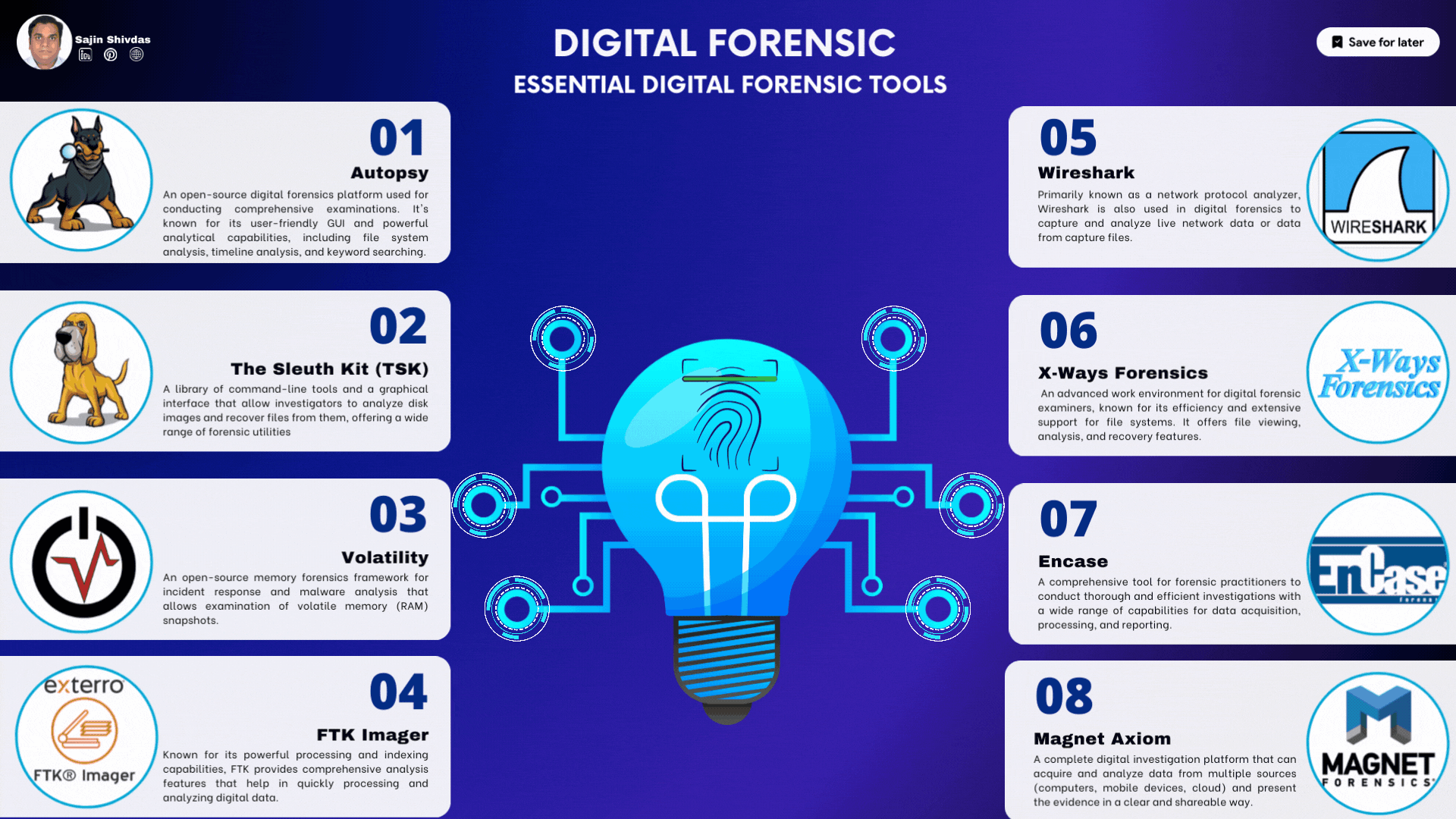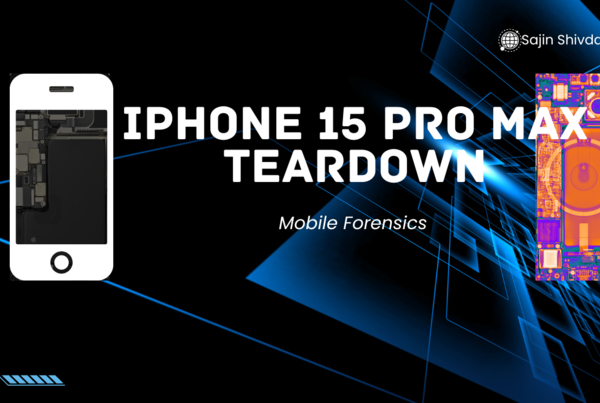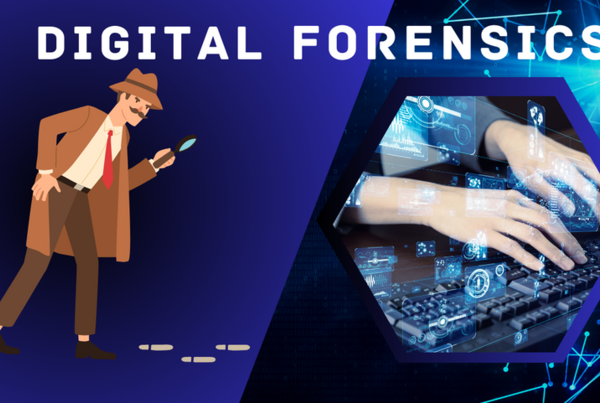Essential Digital Forensics Tools
- Autopsy
- The Sleuth Kit (TSK)
- Volatility
- FTK Imager
- Wireshark
- X-Ways Forensics
- Encase
- Magnet Axiom
Digital forensics is a field that relies heavily on specialized tools to gather, preserve, analyze, and report on digital evidence. Below are 08 essential digital forensics tools, widely recognized for their effectiveness in supporting the digital forensics process

Autopsy
- Developer: Basis TechnologyKey Features:
- Modular Architecture: Autopsy is designed with a plug-in architecture, allowing for the addition of new modules to extend its capabilities. This design supports a wide range of functionalities, from file system analysis to keyword searching and web artifact analysis.
- User-Friendly Interface: It features a graphical user interface (GUI) that simplifies the investigation process, making it accessible to both beginners and experienced professionals.
- Timeline Analysis: This tool provides timeline analysis features that help investigators visualize events that occurred on the device, making it easier to pinpoint when specific actions were taken.
- Keyword Search and Filtering: Autopsy allows for robust keyword searches, including the use of regular expressions. Investigators can filter results to quickly find relevant data.
- Data Carving: It can recover deleted files and unallocated space to find evidence that may not be immediately visible.
- Web Artifacts: Autopsy excels in extracting web browsing history, bookmarks, and cookies, which can be crucial for investigations involving online activities.
Use Cases: Autopsy is widely used for open-source intelligence (OSINT), law enforcement investigations, and corporate incident response. It is suitable for analyzing hard drives, smartphones, and other digital media.
The Sleuth Kit (TSK)
- Developer: Brian Carrier
- Key Features:
- File System Analysis: Provides tools for analyzing file systems in a forensic manner, helping to uncover deleted and hidden files.
- Command-Line Interface: Allows for batch processing and integration into other forensic workflows.
- Wide File System Support: Supports numerous file systems, including NTFS, FAT, ExFAT, HFS+, and Ext2/3/4.
- Use Cases: The Sleuth Kit is often used in conjunction with graphical interfaces like Autopsy for comprehensive digital investigations, particularly for file system forensics.
Volatility
- Developer: The Volatility Foundation
- Key Features:
- Memory Analysis: Specializes in analyzing volatile memory (RAM) to extract information about running processes, network connections, and more.
- Plugin Architecture: Offers a flexible plugin architecture, allowing researchers and investigators to extend its capabilities.
- Cross-Platform: Supports memory dumps from Windows, Linux, Mac, and Android systems.
- Use Cases: Volatility is crucial for incident response and malware analysis, helping investigators to uncover evidence that resides in memory, which is not captured by disk-based forensic tools.
FTK Imager
- Developer: AccessData
- Key Features:
- Integrated Processing: Streamlines the collection, processing, and analysis of digital evidence in a single case file to ensure data integrity.
- Comprehensive Analysis Tools: Includes capabilities for text and multimedia analysis, decryption, password cracking, and more.
- Visual File Analysis: Offers graphical file analysis to help identify relevant evidence quickly.
- Artifact Recovery: Efficient at recovering a wide range of artifacts, including internet history, email, and application data.
- Use Cases: FTK is widely used in legal, law enforcement, and corporate investigations for its robust analysis capabilities and support for a wide range of data types.
Wireshark
- Developer: The Wireshark team
- Key Features:
- Live Capture and Offline Analysis: Offers the ability to capture live packet data from a network interface and also analyze previously captured files.
- Rich VoIP Analysis: Can analyze VoIP traffic, including SIP and RTP protocols, to help understand VoIP call flows and troubleshoot issues.
- Protocol Hierarchy Statistics: Provides insights into the types of traffic on the network, helping analysts to quickly identify unusual patterns.
- Use Cases: Wireshark is indispensable for network forensics and security analysis, offering deep insights into network traffic and potential security breaches.
X-Ways Forensics
- Developer: X-Ways Software Technology AG
- Key Features:
- Efficient Workflow: Known for its efficiency and flexibility in managing forensic casework, allowing for fast and comprehensive analysis.
- File System Support: Offers extensive support for various file systems, enabling analysis of a wide range of digital storage devices.
- Advanced Searching: Features include advanced searching capabilities, file carving, and signature analysis for recovering deleted or hidden data.
- Use Cases: X-Ways Forensics is used by forensic professionals for its rigorous data analysis capabilities, particularly in complex cases requiring detailed examination.
Magnet Axiom
- Developer: Magnet Forensics
- Key Features:
- Artifact-First Approach: Focuses on the most relevant data first, helping investigators quickly find the evidence that matters.
- Integrated Case Management: Allows for the seamless management of evidence and findings within a single case file across different devices and data sources.
- Cloud Data and Social Media: Provides robust tools for acquiring and analyzing data from cloud storage and social media platforms.
- Use Cases: Magnet AXIOM is utilized for a comprehensive examination of digital evidence from computers, mobile devices, and cloud sources, making it a go-to solution for modern digital investigations.
Encase
- Developer: OpenText (formerly Guidance Software)Key Features:
- Comprehensive Data Acquisition: EnCase can acquire data in a forensically sound manner from a wide variety of devices, including desktops, laptops, servers, and mobile devices across different operating systems.
- Deep Analysis Capabilities: It offers deep forensic analysis, allowing investigators to uncover hidden or deleted data, analyze file structures, and view files in their native format.
- Evidence File Container (E01): EnCase uses its proprietary E01 evidence file format to compress, encrypt, and password-protect forensic images, ensuring the integrity and security of the evidence.
- EnScript Programming Language: EnCase features its own scripting language, EnScript, which allows users to automate tasks and create custom applications within the EnCase environment.
- Advanced Reporting: Provides customizable reporting tools that enable forensic professionals to generate detailed and comprehensive reports suitable for legal proceedings.
Use Cases: EnCase is utilized across various sectors, including law enforcement, government, and corporate environments. It is particularly valuable in criminal investigations, corporate litigation, and compliance audits.









